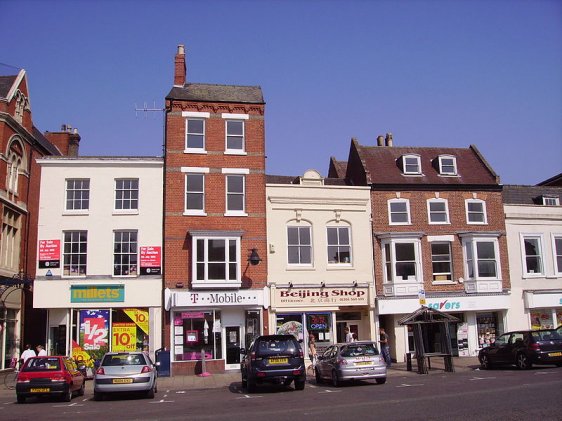 Boston, Lincolnshire, England: Source: https://commons.wikimedia.org/wiki/File:Houses_in_Boston_01.JPG
Boston, Lincolnshire, England: Source: https://commons.wikimedia.org/wiki/File:Houses_in_Boston_01.JPGAuthor: Immanuel Giel

Boston is a small port town in Lincolnshire, England. This is the town that gave its name to Boston, Massachusetts. It has a population of around 60,000 people (2012 estimate).
The name Boston is a contraction of "St Botolph's Stone". There is a local story that the town was founded by a monk named Botolph in AD 654, on the banks of the River Witham. However, the story has to be treated as myth, as the river did not flow near the site of present-day Boston.
Boston was also not listed in the Domesday Book of 1086. Instead the settlement of Skirbeck was mentioned. At that time, Boston was part of Skirbeck. Today it is the other way around, and Skirbeck is now a suburb to Boston, which grew as a port town in the 11th and 12th centuries.
Boston became a port of the Hanseatic League in the 13th century. Its chief trade was in wool, though it also exported salt, grain and lead. By the 14th century it had all four orders of friars namely the Dominicans, Franciscans, Carmelites and Augustinians. These faced closure under King Henry VIII.
In 1607, a group of pilgrims called the Scrooby Congregation led by English Protestant Separatists William Brester and William Bradford who decided to emigrate, to escape from the teaching of the Church of England. They left for the Netherlands, but was bought back to England, because unsanctioned emigration was forbidden. They were tried at the Boston Guildhall. Imprisoned for a while, they were eventually released, and again they sailed to the Netherlands, where they settled in Leiden. Then in 1620, they relocated again, this time on board the Mayflower, setting sail for New England.
 St Botolph's Church, Boston: Source: https://commons.wikimedia.org/wiki/File:Stump%26Ingram.jpeg
St Botolph's Church, Boston: Source: https://commons.wikimedia.org/wiki/File:Stump%26Ingram.jpegAuthor: BardofL

Visiting Boston
From London, take the M1 motorway heading north until Exit 25, then continue east on the A52 road until you reach Boston.Places of Interest in Boston
- Boston Guildhall: Place where the pilgrims were tried for sailing off to the Netherlands. It was converted into a museum in 1929.
- Maud Foster Tower Windmill: Windmill constructed in 1819. It is the tallest operating windmill in England, at 24.4 m (80 ft), and serves as a working museum.
- Pilgrim Fathers Memorial: Memorial on the north bank of The Haven commemorating the attempt by the Scrooby Congregation to find religious freedom in September, 1607.
- St Botolph's Church: The largest Anglican parish church in England. it also has one of the highest church towers in England. It is known localled as The Stump.
 Latest updates on Penang Travel Tips
Latest updates on Penang Travel Tips

Copyright © 2003-2025 Timothy Tye. All Rights Reserved.

 Go Back
Go Back